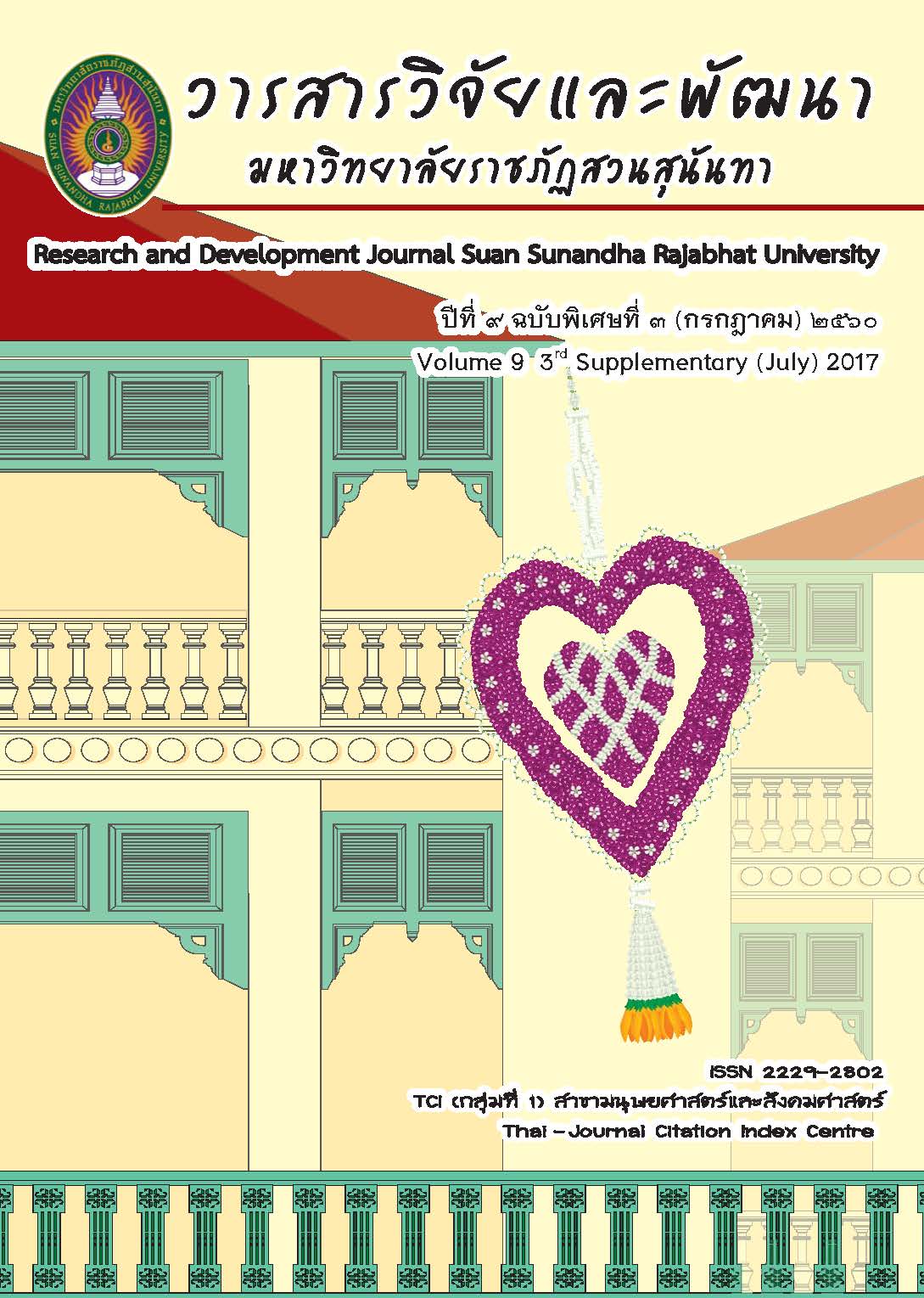บุพปัจจัยที่มีผลต่อการพัฒนาแผนยุทธศาสตร์การค้าชายแดนไทย – สาธารณรัฐประชาธิปไตยประชาชนลาวสู่ประชาคมเศรษฐกิจอาเซียน
DOI:
https://doi.org/10.53848/irdssru.v9i3%20SUP.214272คำสำคัญ:
แผนยุทธศาสตร์, การค้าชายแดน, ประชาคมเศรษฐกิจอาเซียนบทคัดย่อ
การทาวิจัยเรื่อง บุพปัจจัยที่มีผลต่อการพัฒนาแผนยุทธศาสตร์การค้าชายแดนไทย –
สาธารณรัฐประชาธิปไตยประชาชนลาวสู่ประชาคมเศรษฐกิจอาเซียน มีวัตถุประสงค์เพื่อ ศึกษาระดับ
ความสาคัญของบุพปัจจัยของนโยบายส่งเสริมจากภาครัฐบาล และความสัมพันธ์ของบุพปัจจัยของ
นโยบายส่งเสริมจากภาครัฐบาลกับแผนยุทธศาสตร์การค้าชายแดนไทย-สปป.ลาว (ด่านเชียงของ)
กลุ่มตัวอย่าง ได้แก่ ผู้ประกอบการ 240 ราย ตอบแบบสอบถาม และสัมภาษณ์ผู้บริหารระดับสูง
กระทรวงพาณิชย์ 6 ท่าน ในการวิเคราะห์ข้อมูลผู้วิจัยได้ใช้เทคนิคการวิเคราะห์ความสัมพันธ์ระหว่าง
ตัวแปรที่เกี่ยวข้อง การวิเคราะห์ถดถอยพหุเชิงชั้น และการวิเคราะห์เส้นทาง ผลการวิจัยพบว่า
(1) นโยบายส่งเสริมจากภาครัฐบาลเป็นปัจจัยที่มีความสาคัญมากต่อประสิทธิผลของการพัฒนาแผน
ยุทธศาสตร์การค้า ส่วนความสัมพันธ์ระหว่างคู่ค้า และปัจจัยด้านต้นทุนสินค้า มีความสาคัญรองลงมา
ตามลาดับ และ (2) ประสิทธิผลของการพัฒนาแผนยุทธศาสตร์การค้าชายแดนไทย-สปป.ลาว สู่เศรษฐกิจอาเซียน
ขึ้นอยู่กับปัจจัยด้านความสัมพันธ์ระหว่างคู่ค้า และนโยบายส่งเสริมภาครัฐ ส่วนปัจจัยด้านต้นทุนสินค้า
แม้ไม่มีความสัมพันธ์เชิงสาเหตุทางตรงต่อการพัฒนาแผนยุทธศาสตร์การค้าก็ตาม แต่มีความสัมพันธ์
ทางตรงกับปัจจัยด้านความสัมพันธ์ระหว่างคู่ค้าและนโยบายส่งเสริมจากภาครัฐบาล
ข้อเสนอแนะจากการวิจัย ในการพัฒนาแผนยุทธศาสตร์การค้าชายแดน ต้องคานึงถึง
ความสัมพันธ์ระหว่างคู่ค้า และนโยบายส่งเสริมจากภาครัฐบาล โดยเฉพาะการส่งเสริมความรู้แก่
ผู้ประกอบการในด้านการจาหน่ายสินค้าที่มีคุณภาพ ซึ่งถือว่าเป็นข้อได้เปรียบในการแข่งขันทางการค้า
นอกจากนี้รัฐบาลไทยควรส่งเสริมการจัดการสารวจตลาดความต้องการด้านสินค้าอุปโภคและบริโภค
ของผู้บริโภค สปป.ลาว รวมทั้งเขตชายแดนไทยด้วย
References
reach for the stars. Works
Management. pp. 34-36. n.d.
Chiquiar, D., Hanson, G.H. (2005).
International migration, selfselection,
and the distribution of
wages: evidence from Mexico
and the United States. J. Polit.
Econ. 113 (2), pp. 239–281.
Christopher, P. & David J, T. (2001). The
Analysis of Market Power and
Market Definition in the Context of
Rapid Innovation. International
Journal of Industrial Organization.
9(5), pp. 665 693.
Collis, D.J. (1991). A resource-based analysis of
global competition. Strategic
Management Journal. 12, 49-68.
Department of Export Promotion Ministry
of Commerce (2554). Manual of
trade and investment PDR Laos.
Bangkok: Commercial Bureau Department
of Export Promotion of Thailand.
Department of Foreign Trade. (2555).
Workshop. Strategy and Action
Plan To promote cross-border
trade with neighboring countries.
Director Bureau of Trade and
Investment Cooperation. (Online).
Searched, June 30, 2559 Retrieved
from http: / / www. dft. go. th/ bts/
mission-trade-border.
Department of Trade Negotiations. (2557).
Knowledge about investment in
ASEAN, Laos. (1st edition).
Bangkok: Ministry of Commerce.
Director Bureau of AEC and Asian Trade
Development. (2557). Factsheet - Laos.
the Department of International
Trade Promotion Ministry of Commerce.
(Online) Searched, March 15, 2558
Retrieved from http://aec.ditp.go.th/.
Eusebio, R., Andreu, J.L. & Belbeze, M.P.L.
(2007). Internal key factors in
export performance: A comparative
analysis in the Italian and Spanish
textile-clothing sector (part 1).
Journal of Fashion Marketing and
Management. 11(1), 9-23.
Filatotchev, I., Liu X., Buck T. & Wright, M.
(2009). The export orientation and
export performance of hightechnology
SMEs in emerging
markets: The effects of knowledge
transfer by returnee entrepreneurs.
Journal of International Business.
Studfiles/brochures/dec-05.pdf.
Gebhardt, G. F., Carpenter, G. S. & Sherry,
J. F. (2006). Creating a market
orientation: A longitudinal grounded
analysis of cultural transformation.
Journal of Marketing. 70(4), 37 55.
Hamilton, B., Whalley, J. (1984). Efficiency
and distributional implications of
global restrictions on labor
mobility: calculations and policy
implications. J. Dev. Econ. 14( 1) ,
61–75.
Hansen, K. (2004). Measuring performance
at trade shows - scale development
and validation. Journal of Business
Research. 57(1), 1–13.
Humphrey, A. (2005). SWOT Analysis for
Management Consulting. SRI
Alumni.
JohansonJ. & Mattsson, L. G. (1993).
Internationalisation in Industrial
Systems - aNetwork Approach, in
Hood N./Vahlne J. E. (eds.),
Strategies in Global Competition.
London: Croom Helm 1988, 287-314.
Kumar, R., Singh, R. K., & Morgan, R.
(2014). Strategy developmentby
Indian SMEs for improving
coordination in supply chain: an
empirical study. Competitiveness
Review, 24(5), 414e432.learning
organization. Academy of Management
Journal. 40, 1150-1174.
Lee, C. H. & Kim, S. Y. (2008). Differential
effects of determinants on multi
dimensions of trade show
performance: by three stages of
pre-show, at show, and post-show
activities. Industrial Marketing
Management. 37(7), 784 –796.
Louis, K. S. (1998). Effects of teacher
quality work life in secondary
schools on commitment and sense
of efficacy. School Effectiveness
and School Improvement. 9(1), 1-27.
Mayda, A.M. (2010). International
migration: a panel data analysis of
the determinants of bilateral flows.
J. Popul. Econ. 23(4), 1249–1274.
Nevins, J.L. & Money, R.B. (2008).
Performance implications of
distributer’s effectiveness, trust and
culture in import channels of
distribution. Industrial Marketing
Management. 37, 46-58. Newsletter.
SRI International. Retrieved from
https://www.sri.com/sites/default/
Olson, E. M., Slater, S. F. & Hult, G. T. M.
(2005). The performance implications of
fit among strategy, marketing
organisation structure and strategic
behavior. Journal of Marketing.
69(3), 49 65.
Ricardo, K, D. (1823). Rdenesexpedidaspor el
estado de yucat. New York:
Random House.
Silva, S. C., Bradley F., et al. (2012).
Emprical test of the trust-performance
link in an international alliance.
International Business Review. 21,
293-306.
Simonin, B. (1997). The Important of
Collaborative know-how: An
empirical test of the.
Smith, A. (1976). The Theory of Moral
Sentiments, D.D. Raphael & A.L.
Macfie. pp. 189–190. Clarendon
Press.
Sousa, C. M. P., Martinez-Lopez, F. J. &
Coelho, F. (2008). The determinants
of export performance: A review of
the research in the literature
between 1998 and 2005. International
Journal of Management Reviews.
10(4), 343–374.
Sousa, C.M.P., Bradley,F. ( 2008)
Antecedents of international pricing
adaptation and export performance.
Journal World Business. 43, 307-
320.
Sripatthangkura, K. (2557). The study of
border trade - trade through the
border with Thailand in ASEAN :
Trade and freight border -
crossing Thailand - Laos - China.
Bangkok: King Prajadhipok's Institute.
Stoian, M.C., Rialp, A, Rialp, J. (2011).
Export performance under the
microscope: A glance through
Spanish lenses. International
Business Review. 20, 117-135.
Suchart Prasithrathsint ( 2556) . Using
statistical research properly and
global scale. (6th edition). Bangkok:
Part Sam Lada Partnership.
Tanner, J.F., Chonko, Lawrence B. &
Ponzurick, T.V. (2001). A learning
model of trade show attendance.
Journal of Convention & Exhibition
Management. 3(3), 3-26.
Theodosiou, M., Kehagias, J., Katsikea, E.
(2012). Strategic orientations, marketing
capabilities and firm performance:
An empirical investigation in the
context of frontline managers in
service organizations. Industrial
Marketing Management. 41, 1058-
1070.
Williams, W. (1971). Social Policy Research
and Analysis: The Experience in
The Federal Social Agencies. New
York: American Elsevier Publishing
Co.
Zhou, K. Z., Li, J. J., Zhou, N. & Su, C.
(2008). Market orientation, job
satisfaction, product quality and
firm performance: Evidence from
China. Strategic Management Journal.
Downloads
เผยแพร่แล้ว
How to Cite
ฉบับ
บท
License
บทความที่ได้รับการตีพิมพ์เป็นลิขสิทธิ์ของ สถาบันวิจัยและพัฒนา มหาวิทยาลัยราชภัฎสวนสุนันทา
ข้อความที่ปรากฏในบทความแต่ละเรื่องในวารสารวิชาการเล่มนี้เป็นความคิดเห็นส่วนตัวของผู้เขียนแต่ละท่านไม่เกี่ยวข้องกับมหาวิทยาลัยราชภัฎสวนสุนันทา และคณาจารย์ท่านอื่นๆในมหาวิทยาลัยฯ แต่อย่างใด ความรับผิดชอบองค์ประกอบทั้งหมดของบทความแต่ละเรื่องเป็นของผู้เขียนแต่ละท่าน หากมีความผิดพลาดใดๆ ผู้เขียนแต่ละท่านจะรับผิดชอบบทความของตนเองแต่ผู้เดียว




